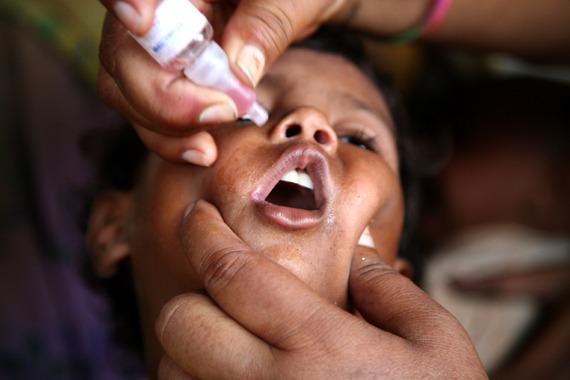Joint blog: Dr Flavia Bustreo, WHO ADG and Vice Chair of Gavi, with Dr Marie-Paule Kieny, WHO ADG , Health Systems and Innovation
Suspense and high stakes
It's no secret that vaccines are considered one of the greatest global health achievements. Every year they avert an estimated 2 to 3 million deaths.
During the last two centuries, vaccines have eradicated smallpox, reduced global child mortality rates, and prevented countless birth defects and lifelong disabilities, such as paralysis from polio.
But, the success story of vaccination is not yet finished.
There's still a book waiting to be written that's guaranteed to keep all of us, not just global health experts, up at night. Fortunately, many of the chapters full of suspense, high stakes and perseverance are being written right now.
Fast-tracking vaccine development - Ebola
In the past two years, vaccination research and development has kept the world on its toes.
During the height of the Ebola epidemic, the urgency of saving lives accelerated research and development efforts. By bringing together the best minds in vaccinology, clinical trials for a number of candidate Ebola vaccines rapidly got underway.
WHO was directly involved in trials of the VSV-EBOV (Merck, Sharp & Dohme) vaccine, one of the most promising Ebola vaccines being used in trials today. Preliminary results of the trial in Guinea indicate that the vaccine might be very effective. The vaccine is also being used to contain "flare-ups" of small numbers of new cases which are ongoing.
The trials using the VSV-EBOV vaccine have been conducted as "ring vaccination", used in the past for smallpox vaccination. Through ring vaccination, the primary and secondary contacts of each person infected with Ebola are vaccinated, to form a protective ring of immunity, and to prevent further spread of the virus.
It is hoped that sufficient data from clinical trials will enable Ebola vaccines to be licensed in the near future. This will make vaccination in a future outbreak much easier.
Preparing for outbreaks - Zika
In fast-tracking the Ebola vaccine WHO learned some lessons and developed the R&D Blueprint for Action to Prevent Epidemics, which ensures that targeted research and development can quickly bring medical technologies, including vaccines, to people during epidemics.
The Blueprint aims to reduce the time between the declaration of an international public health emergency and the availability of effective tests, vaccines and medicines that can be used to save lives and avert crisis.
We're already seeing this plan in action in the Zika response. With the Zika virus now linked to microcephaly in babies and other neurological disorders, more than 60 companies and research institutions are already working on a number of products, including 18 vaccines targeted for women of childbearing age.
While no vaccine has yet been tested on humans, the swiftness of the response provides hope.
High hopes for dengue and malaria vaccines
Perseverance in vaccine development is also starting to pay off in other areas.
During the last 60 years, the incidence of dengue has increased 30-fold. An estimated 390 million infections occur every year, with a quarter of people infected showing symptoms. At present the main method of preventing disease transmission is by controlling the Aedes mosquito, the same mosquitoes that transmits Zika.
However, the WHO Strategic Advisory Group of Experts (SAGE) on Immunization recently recommended that Dengvaxia (CDY-TDV), a vaccine for dengue, be considered for use in geographic settings with high endemicity. Additional vaccines candidates are already in various stages of development.
Because both multi-drug resistance and insecticide resistance are huge issues in eliminating malaria, new tools are needed to protect the 3.2 billion people at risk of the disease. The first malaria vaccine, RTS,S, is a step forward.
In 2015, SAGE advised WHO and partners to pilot implementation of RTS,S, which was developed by GlaxoSmithKline Biologicals and the PATH Malaria Vaccine Initiative, with support from the Bill & Melinda Gates Foundation and a network of African research centres. The vaccine is set to be piloted in children aged 5-9 months in 3 to 5 sub-Saharan African countries in the coming months.
Research and development efforts must continue
It's clear that new vaccines can be breakthroughs for global public health. Now, we need to ensure these breakthroughs become the norm.
In order to keep pace with new threats, investment in research and development must continue with the same intensity that we have seen in recent months.
The new 2030 sustainable development agenda is calling on governments to support research and development for new vaccines so that diseases like dengue, Ebola, malaria and Zika can become diseases of the past--ones we only read about in a future best-selling book about long-gone diseases.
As we mark World Immunization Week 2016, let's continue to write the history of vaccination, celebrate the research and development successes, and work to ensure people of all ages receive the vaccines they need to help them stay healthy throughout their lives.
Find more information on vaccines and World Immunization Week at www.who.int/life-course.

